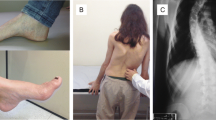Abstract
Left ventricular hypertrophy (LVH) is a frequent finding in Friedreich’s ataxia (FRDA). In previous studies treatment with idebenone, a synthetic analogue of coenzyme Q10, has been associated with a substantial decrease in myocardial hypertrophy, despite great variability in cardiac responsiveness among patients. Here we present the results of a retrospective analysis of a cohort of 35 patients (20 with LVH, 15 without LVH) with confirmed molecular diagnosis of FRDA, treated with idebenone 5 mg/kg/day for up to five years. At the end of the study, we found an increase of interventricular septum and posterior wall thickness in the group without LVH before treatment and no change in the group with LVH before treatment. The neurological picture of the disease significantly deteriorated with time in both groups.
Similar content being viewed by others
References
Artuch R, Aracil A, Mas A et al (2002) Friedreich ataxia: idebenone treatment in early stage patients. Neuropediatrics 33:190–193
Buyse G, Mertens L, Di Salvo G et al (2003) Idebenone treatment in Friedreich’s ataxia: neurological, cardiac, and biochemical monitoring. Neurology 60:1679–1681
Campuzano V, Montermini L, Moltò MD et al (1996) Friedreich’s ataxia: autosomal recessive disease caused by an intronic GAA triplet repeat expansion. Science 271:1423–1427
Di Prospero NA, Baker A, Jeffries N, Fishbeck KN (2007) Neurological effects of high dose idebenone in patients with Friedreich’s ataxia: a randomized, placebo-controlled trial. Lancet Neurol 6:878–886
Dutka DP, Donnelly JE, Palka P, Lange A, Nunez DJ, Nihoyannopoulos P (2000) Echocardiographic characterization of cardiomyopathy in Friedreich’s ataxia with tissue Doppler echocardiographycally derived myocardial velocity. Circulation 102:1276–1282
Filla A, De Michele G, Caruso G, Marconi R, Campanella G (1990) Genetic data and natural history of Friedreich’s disease: a study of 80 Italian patients. J Neurol 237:345–351
Gillis JC, Benefield P, McTavish D (1994) Idebenone: a review of its pharmacodynamic and pharmacokinetic properties and therapeutic use in age-related cognitive disorders. Drug Aging 5:133–152
Harding AE (1981) Friedreich’s ataxia: a clinical and genetic study of 90 families with analysis of early diagnostic criteria and intrafamiliar clustering of clinical features. Brain 104:589–620
Henry WL, Gardin JM, Ware JH (1980) Echocardiographic measurements in normal subjects from infancy to old age. Circulation 62:1054–1061
Mariotti C, Solari A, Torta D, Marano L, Fiorentini C, Di Donato S (2003) Idebenone treatment in Friedreich patients: one-year-long randomized placebo controlled trial. Neurology 60:1676–1679
Meyer C, Schmid G, Gorlitz S, Ernst M, Wilkens C, Wilhelms I et al (2007) Cardiomyopathy in Friedreich’s ataxia—assessment by cardiac MRI. Mov Disord 22(11):1615–1622
Pineda M, Arpa J, Montero R, Aracil A, Dominguez F, Galvan M, Mas a, Martorell L et al (2008) Idebenone treatment in paediatric and adult patients with Friedreich ataxia: long term follow-up. Eur J Paediatr Neurol 12(6):470–475
Ribai P, Pousset F, Tanguy ML, Rivaud-Pechoux S, Le Ber I, Gasparini F, Charles P, Bèreaud AS et al (2007) Neurological, cardiological and oculomotor progression in 104 patients with Friedreich’s ataxia during long-term follow up. Arch Neurol 64:558–564
Rotig A, de Lonlay P, Chretien D, Foury F, Koenig M, Sidi D, Munnich A, Rustin P (1997) Aconitase and mitochondrial iron–sulphur protein deficiency in Friedreich ataxia. Mol Cell Biochem 174:215–217
Rustin P, Rotig A, Munnich A, Sidi D (2002) Heart hypertrophy and function are improved by idebenone in Friedreich’s ataxia. Free Radic Res 36:467–469
Steinsapir K, Lewis W (1985) Dilated cardiomyopathy associated with Friedreich’s ataxia. Arch Pathos Lab Med 109:454–456
Author information
Authors and Affiliations
Corresponding author
Rights and permissions
About this article
Cite this article
Rinaldi, C., Tucci, T., Maione, S. et al. Low-dose idebenone treatment in Friedreich’s ataxia with and without cardiac hypertrophy. J Neurol 256, 1434–1437 (2009). https://doi.org/10.1007/s00415-009-5130-6
Received:
Revised:
Accepted:
Published:
Issue Date:
DOI: https://doi.org/10.1007/s00415-009-5130-6




